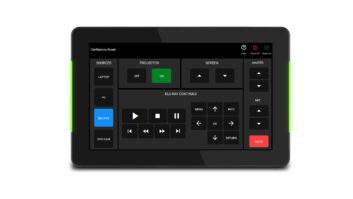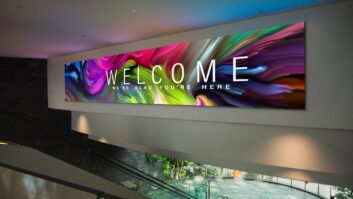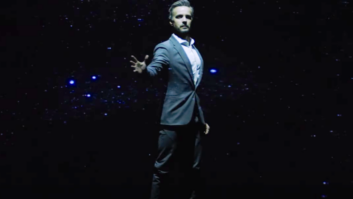 Lockdowns might be easing, but for houses of worship (HoW) live streamed services and quality video content aren’t going anywhere. For many worshippers, being able to access religious services and content virtually was not only essential for observing their faith throughout lockdowns, but also gave them the flexibility to worship when they wanted, from wherever they wanted.
Lockdowns might be easing, but for houses of worship (HoW) live streamed services and quality video content aren’t going anywhere. For many worshippers, being able to access religious services and content virtually was not only essential for observing their faith throughout lockdowns, but also gave them the flexibility to worship when they wanted, from wherever they wanted.
While services may soon resume across Europe, it’s likely that people of faith will still expect to be able to access additional video content and tune into services virtually should they need to. To make sure that they continue to meet expectations, HoWs will need to keep up with the latest video trends. What’s more, stepping their AV up will help HoW’s reach new audiences and expand their communities.
Interactive live streaming
In 2020, the religious sector was forced to shift to an entirely remote model. For many, this meant carefully pre-recording services with the aim of giving their followers a bank of content to lean on throughout lockdowns. However, there were some HoWs which took it a step further by live streaming their services, which were simultaneously recorded and broadcast, or indeed offering a hybrid model of both live and pre-recorded content.
With social distancing, this became a challenge for those without the right kit. In response, we saw the religious sector turning to PTZ cameras which can be remotely manoeuvred by volunteers to film. The content captured by these cameras was far more engaging and enabled speakers to move freely throughout the frame – helping those viewing the content feel that they were closer to their spiritual leaders.
Now that this has become the norm, viewers will begin to expect more from these live streamed services, particularly as worshippers adopt a hybrid model of attending remotely and in-person. Those joining remotely will expect the same level of interaction and participation as their counterparts joining in real life.
Enabling virtual attendees to comment and ask questions throughout live streamed ceremonies will be paramount. A key element to facilitating this is in reducing latency, so that there isn’t a delay between the moment a subject is recorded and displayed on the content delivery network. To do this, HoWs need to select kit which supports streaming protocols and enable high-speed encoding and delivery. For instance, Canon’s CR-N500 and CR-N300 cameras enable IP streaming with support for RTMP/RTMPS and NDI|HX protocols, to deliver high-quality footage with low-latency, that is suitable for switching in a live production environment, allowing audiences to watch and react in real-time.
Increasing production value
Viewer expectations for content are soaring across industries and the religious sector is no different. They expect the same level of production value from live-streamed content shared on social platforms like YouTube as they do from that created for entertainment platforms and broadcasters.
There are two key elements to replicating this production value. The first is image quality. 4K has become the standard for video resolutions and worshippers will expect content to be shot in this resolution, so that they can truly immerse themselves within religious services.
For many HoWs, purchasing expensive camera kit with a constrained budget seems like an unnecessary cost. Even if 4K isn’t required, having a camera with a 4K sensor can produce outstanding HD quality content, while also future-proofing these investments for the future.
The second factor to achieve a high production standard is in how well the content is actually captured. For the religious sector, where camera operators tend to be volunteers with limited experience in videography, its important that the kit is easy to use so that they don’t miss the shot but can also achieve high quality without too much technical knowledge required. Selecting easy-to-use cameras such as those with supportive features like Dual Pixel AF, for accurate, sharp focusing on subjects and Scene Mode, which automatically selects the perfect settings for the scenario, simplifies operation. What’s more, choosing a camera with a familiar layout, like a DSLR or mirrorless camera, will give volunteers greater confidence in the camera.
Multi-format content
Whilst engagement will be a requirement for HoWs, freedom of choice will be an equally important demand from remote worshippers. This will present itself in a variety of ways, both in terms of having live streamed and recorded content, but also offering content across multiple platforms and within different video formats. As HoWs seek to engage with younger audiences, the availability of content across social media platforms such as YouTube, Facebook and others will be extremely important, meaning protocols such as RTMP is even more important in today’s day and age.
From the perspective of live or pre-recorded content, viewers want to be able to watch content on demand and press pause when they need to. This will be fairly simple to implement for HoWs, which can easily leverage the same recording kit for both. What they will need to ensure, however, is that the camera they use can deliver consistently high-quality video for both live streamed and recorded video. Choosing a camera such as the aforementioned CR-N500, which leverages Canon Log 3 and wide dynamic range modes, produces the best possible HDR results which can be transmitted directly to a content delivery network or recorded for post-production.
Multi-streaming gives service creators the ability to reach more worshippers and offer them the same level of experience regardless of what platform they view through. When it comes to simulcasting, the choice of camera becomes even more important as content creators have to plug their footage into hardware, software or a cloud service that can publish this to multiple platforms. Choosing a camera with multiple connectivity options such as Power over Ethernet (PoE+), HDMI, 3G-SDI, means greater compatibility with multi-streaming tools and the ability to transmit different resolutions of video content.
HoWs join the battle for image quality
As 4K becomes the new standard for video resolution, viewer expectations continue to soar across industries and the religious sector is no different. Worshippers will expect that live streamed and recorded content will be shot in equally high quality – enabling them to immerse themselves within religious services.
When we say that HoWs need to build a 4K production system, what we mean is that it is not just about the camera they use but the entire infrastructure, from video recording all the way to distribution and output that needs to facilitate this resolution. It’s important to select cameras that can capture high quality 4K but also offers connectivity to transmit 4K resolution imagery, and work alongside other key pieces of production kit, such as controllers, switchers and other cameras.
At the heart of these trends, is the need for a robust video production system that seamlessly works together and enables HoWs to meet future content demands. Without considering the process from end-to-end, HoWs will likely not be able to build a production system that can meet the video content demands of today and be adapted for those of the future. If you haven’t already, it’s time to consider your production requirements.







